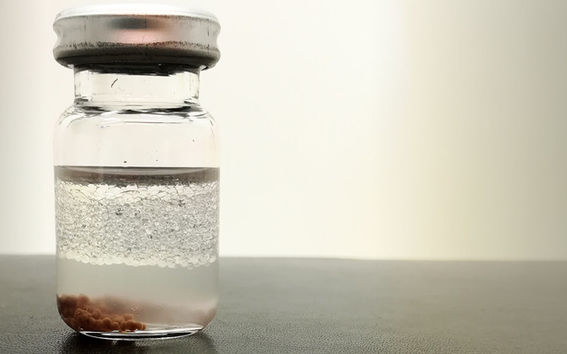Breakthrough in lignin research: spherical particles multiply enzyme efficiency

Researchers at Aalto University and York University have succeeded in creating a water-repellent composite structure out of lignin particles, in which the enzymes or biocatalysts can be separated from surrounding water. The breakthrough was accomplished when the researchers discovered that, by regulating the surface charge of single lignin particles, enzymes can be made to adhere to the surface of particles. As material supporting the structure, they utilised a natural polymer isolated from seaweed.
The starting point for the research was the need to utilise lignin, a pulp industry by-product, for new, large-scale purposes. The researchers were surprised to discover that, when introduced, the lignin particles multiplied enzyme efficiency and enabled enzyme recycling in a synthetic reaction that would not otherwise occur in water.
“The beauty of this method lies in its simplicity and scalability. We are already able to manufacture lignin particles in batches of several kilogrammes. Of course, we hope that this will become a sustainable option for the enzyme industry to replace fossil materials in technical applications”, says Postdoctoral Researcher Mika Sipponen.
Lignin not only multiplies enzyme efficiency, it also shows good results in comparison to those substances currently on the market, created from unsustainable sources. “The commercial enzyme we use as reference is attached to the surface of synthetic acrylic resin produced from fossil raw materials. In comparison, this new biocatalyst was at best twice as active”, Sipponen adds.
In the reaction, alcohol and organic acid created in biofuel production produced a water-insoluble ester with a pineapple scent. The process opens up new possibilities for the production of bio-based polyesters, as well.
“We are pleased that the years of investing in the lignin particle research are beginning to produce significant results. We envision several possible uses for spherical particles in green chemistry processes and the development of new materials”, says research leader Professor Monika Österberg.
The research was funded by the Academy of Finland.
The article “Spatially confined lignin nanospheres for biocatalytic ester synthesis in aqueous media” was published today in Nature Communications, DOI 10.1038/s41467-018-04715-6, https://www.nature.com/articles/s41467-018-04715-6
For more information:
Dr. Mika Sipponen
[email protected]
tel +358503013978
Prof. Monika Österberg
[email protected]
tel +358505497218
Read more news

DeployAI Partners Gather for Heart Beat Meeting in Helsinki
The European DeployAI project's partners gathered for the Heart Beat meeting hosted by Aalto University Executive Education in Helsinki.
Aalto computer scientists in ICML 2024
Computer scientists in ICML 2024
In low-hierarchy organisations, even key policy issues are discussed in Slack
In a recent study, Aalto University alumn Lauri Pietinalho, a visiting scholar at New York University's Stern School of Business, and Frank Martela, an assistant professor at Aalto University, investigated how low-hierarchy organisations deal with shared policies in confrontational situations and how authority functions within them.